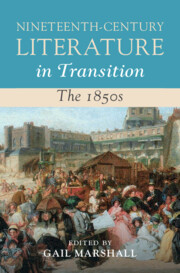Book contents
- Nineteenth-Century Literature in Transition: The 1850s
- Nineteenth-Century Literature in Transition
- Nineteenth-Century Literature in Transition: The 1850s
- Copyright page
- Contents
- Figures
- Contributors
- Acknowledgements
- Introduction
- Chapter 1 Pictures of Nature
- Chapter 2 ‘When I Came Back, It Was … to the Love of a New Generation’
- Chapter 3 George Eliot, the Westminster Circle, and Karl Ernst von Baer’s Embryological Germ Theory
- Chapter 4 The 1850s Sustainability Novel
- Chapter 5 Serialising London in ‘Twice Round the Clock’
- Chapter 6 Theatre in the 1850s
- Chapter 7 Beyond the Art of Conversation
- Chapter 8 Making Soldiers Count
- Chapter 9 Finding the Lost
- Chapter 10 British India in the 1850s
- Chapter 11 Christian Heroism
- Chapter 12 Horsepower in the Railway Age
- Chapter 13 Trauma, Gender, and Resistance
- Chapter 14 The Poetry of Married Life
- Chapter 15 George Eliot, Henry James, Realism, and Europe
- Index
Chapter 13 - Trauma, Gender, and Resistance
Working-Class and ‘People’s’ Literature of the 1850s
Published online by Cambridge University Press: 02 January 2025
- Nineteenth-Century Literature in Transition: The 1850s
- Nineteenth-Century Literature in Transition
- Nineteenth-Century Literature in Transition: The 1850s
- Copyright page
- Contents
- Figures
- Contributors
- Acknowledgements
- Introduction
- Chapter 1 Pictures of Nature
- Chapter 2 ‘When I Came Back, It Was … to the Love of a New Generation’
- Chapter 3 George Eliot, the Westminster Circle, and Karl Ernst von Baer’s Embryological Germ Theory
- Chapter 4 The 1850s Sustainability Novel
- Chapter 5 Serialising London in ‘Twice Round the Clock’
- Chapter 6 Theatre in the 1850s
- Chapter 7 Beyond the Art of Conversation
- Chapter 8 Making Soldiers Count
- Chapter 9 Finding the Lost
- Chapter 10 British India in the 1850s
- Chapter 11 Christian Heroism
- Chapter 12 Horsepower in the Railway Age
- Chapter 13 Trauma, Gender, and Resistance
- Chapter 14 The Poetry of Married Life
- Chapter 15 George Eliot, Henry James, Realism, and Europe
- Index
Summary
Florence Boos examines the proliferation of working-class writing in a variety of genres – poetry, fiction, autobiography, and journalism – at a time when there was a significant middle-class interest in forms of working-class culture. This led to the financing and production of publications such as Howitt’s and People’s Journal, Eliza Cook’s Journal, The Literature of Working Men, and the Dundee-based People’s Journal. The broadly class-based nature of the pervasive violence of the period is acknowledged here as a given in works which experiment with form in order to represent the authenticity of the working-class experience. As Boos concludes, ‘an integration of these writings into our conceptions of Victorian authorship can provide a more comprehensive understanding of the latter, as well as greater appreciation of the unique contributions of mid-century British working-class writers to the literary representation of the social issues of their time’.
- Type
- Chapter
- Information
- Nineteenth-Century Literature in Transition: The 1850s , pp. 294 - 316Publisher: Cambridge University PressPrint publication year: 2025

